Oct 11, 2025
25+ Best Recruitment Automation Tools to Streamline Your Hiring
Recruitment automation tools help HR teams streamline hiring with AI-driven sourcing, ATS management, interview scheduling, and analytics.
Every hiring team knows the slog of sorting resumes, scheduling interviews, and chasing candidates. Recruitment automation tools, such as applicant tracking, resume screening, candidate sourcing, and interview scheduling, promise to cut down on manual work, but many teams struggle to use them effectively. This article provides clear, practical steps for using recruitment automation tools to hire top-quality candidates faster, save time, limit bias, and streamline the entire hiring workflow.
Noxx's AI recruiter puts those steps into action by automating screening, scheduling, and fair scoring so your team focuses on conversations that matter. It reduces admin, improves talent acquisition accuracy, and helps you hire faster without adding headcount.
Table of Content
What Is Recruitment Automation and Why Is It Important?
25+ Best Recruitment Automation Tools
Upload a Job and Get 10 Candidates within 7 Days with Noxx (No Risk, No Upfront Fees)
What Is Recruitment Automation and Why Is It Important?

Recruitment automation uses technology and software to streamline, manage, and optimize repetitive or manual hiring tasks. It covers candidate sourcing, resume parsing, CV screening, interview scheduling, and candidate communication.
These systems use AI, machine learning, natural language processing, and workflow automation to score candidates, surface talent from social profiles, and trigger actions across applicant tracking systems and recruitment CRMs. The goal is to make recruiting more efficient, repeatable, and data-driven while freeing recruiters to do the human work that matters.
How Recruitment Automation Enhances Hiring Efficiency
Recruitment automation often runs alongside human work. Sometimes called hiring automation, it automates parts of the process so recruiters can spend time interviewing and building relationships. This partial automation delegates repetitive workflows to machines while allowing people to apply judgment where nuance matters.
Processes recruitment automation typically facilitates:
Identifying people with targeted keywords in social media profiles and public portfolios.
Early CV screening to surface qualified candidates and reduce manual resume review.
Issuing tailored communications so employers can spend time improving candidate experience.
Streamlining applications, interview scheduling, and online onboarding to speed hiring.
Integrating talent sourcing tools, calendar scheduling, and HRIS systems to keep data flowing.
Why Recruitment Automation Matters: Practical Benefits
Recruiters get time back, teams get consistent processes, and hiring decisions become more measurable. Automation reduces repetitive work, improves candidate engagement through timely communication, and gives hiring managers clear hiring metrics such as time to hire and source effectiveness.
It helps reduce unconscious bias through structured screening and anonymized review workflows, while also enabling collaboration across talent teams and hiring managers.
Constant Communication That Scales
Keeping candidates informed is essential and time-consuming. Automated workflows and chatbots provide status updates, confirm interview times, and answer common questions around the clock.
Email sequencing and SMS notifications keep candidates engaged without manual follow-up. This reduces ghosting and keeps the talent pipeline healthy while freeing recruiters to handle complex candidate conversations.
Effective Candidate Relationship Management
A recruitment CRM and candidate management system lets teams track candidate interactions, log feedback, and flag development opportunities. Automation tags candidates by skills, experience, and interest, making talent pools actionable. The system can surface candidates for future roles and suggest personalized outreach, helping recruiters nurture passive talent and build stronger relationships over time.
Mass Processing Without Losing Quality
When hundreds or thousands of applications are submitted, manual review becomes a bottleneck. Automated resume parsing, keyword matching, and machine learning scoring screen large volumes quickly. This approach allows teams to keep roles open until the right candidate appears, ensuring no viable applicant is overlooked due to volume.
Saving Time and Money
Automating repetitive tasks reduces manual labor and human error. Systems trained to handle resume routing, interview scheduling, and initial screening complete those tasks faster and more consistently than humans. Time saved translates into lower cost per hire and higher recruiter productivity, especially when systems integrate with ATS, recruitment CRM, and payroll or HRIS systems.
Easing Candidate Selection
Narrowing candidate lists is complex. Candidate management systems apply scoring models and structured assessment rubrics so hiring teams can compare applicants on consistent criteria. That cuts down the time recruiters spend scrutinizing each file and helps hiring managers focus on the most relevant candidates.
Better Organization, Fewer Lost Files
Automated systems create a single source of truth for candidate data, interview notes, and compliance documents. Resume parsing and centralized storage make retrieval fast and audit-ready. With consistent record keeping, teams spot process gaps and track hiring metrics without chasing emails or scattered spreadsheets.
Online Assessments for Skills and Compliance
For roles with specific technical requirements, automated testing platforms deliver standardized assessments, manage proctoring where needed, and generate objective scores. These assessments reduce bias by directly evaluating skills and feeding results into candidate profiles, so teams see why a candidate passed or failed.
Constant Communication: Candidate Engagement Tools and Chatbots
Automated messages, FAQ bots, and interview reminders reduce unanswered messages and scheduling friction. Chatbots can route candidate queries, screen eligibility criteria, and collect pre-interview information. These features keep candidates moving through the pipeline and improve perceived responsiveness.
Effective Candidate Relationship Management: Nurture and Talent Pools
Recruitment automation helps build talent pipelines with targeted outreach campaigns, evergreen job campaigns, and talent tagging. When candidates need coaching or skill development, systems can flag opportunities and record progress, turning one-time applicants into future hires.
Mass Processing: Resume Parsing and Bulk Screening
Bulk resume parsing, duplicate detection, and automated disqualification rules handle volume spikes. That enables recruiters to sift through applicants efficiently while preserving quality by applying consistent filters and custom scoring.
Saving Time and Money: Automate Repetitive Workflows
Automated scheduling, interview orchestration, offer letter generation, and onboarding checklists reduce manual hand-offs. Integrations with calendar tools and background screening providers accelerate time to hire and cut administrative costs.
Easing Candidate Selection: Scoring, Interview Guides, and Decision Workflows
Structured interview guides, scorecards, and hiring approval workflows reduce subjectivity. Automation compiles interviewer feedback and ranks candidates for final review, so selection discussions focus on fit rather than data gathering.
Better Organization: Centralized Data and Compliance
Automated tagging, version control for documents, and retention policies keep records orderly and compliant. Searchable candidate profiles and audit trails let teams respond to records requests and improve process audits.
Online Assessments: Proctored Tests and Standardized Scoring
Assessment platforms handle timed tests, coding challenges, and case work with consistent scoring. Results feed into ATS profiles, allowing hiring teams to see objective measures alongside resumes and interview notes.
Three Ways Recruitment Software Can Aid Your Hiring Process
Tracking and Documentation
Recruiting software secures documentation and logs every interaction, from candidate emails to interview feedback. That makes training easier, enables process improvement, and supports compliance with hiring policies and local regulations.
Automation
Top recruitment software includes workflow automation for sourcing, screening, scheduling, and onboarding. These capabilities reduce manual steps, automate candidate routing, and maintain consistent experiences across roles.
Minimizing Bias
Recruitment software supports blind CVs, structured scoring, and diverse sourcing channels. Removing demographic identifiers and using standardized assessments helps hiring teams select on skills and experience alone.
Recruiting Automation Software vs Recruitment Automation: Key Difference
Recruiting automation software describes the actual tools and platforms that perform automated tasks:
Resume parsers
Recruitment CRMs
Chatbots
Interview schedulers
Assessment platforms
Recruitment automation refers to the broader practice of applying those tools within hiring workflows and processes. One is the technology you buy, the other is the strategy and design you use to reduce manual effort and improve hiring outcomes.
Where This Leads: Tools That Automate Recruitment Workflows
A growing number of recruitment automation tools now help companies automate sourcing, resume screening, candidate engagement, interview orchestration, and onboarding.
Expect to see deeper AI-powered candidate matching, better integrations with HRIS and background check vendors, improved recruitment analytics dashboards, and more options for diversity-focused hiring and blind review. The following sections will examine the best tools and practical ways to plug them into your hiring process.
Related Reading
25+ Best Recruitment Automation Tools
1. Noxx
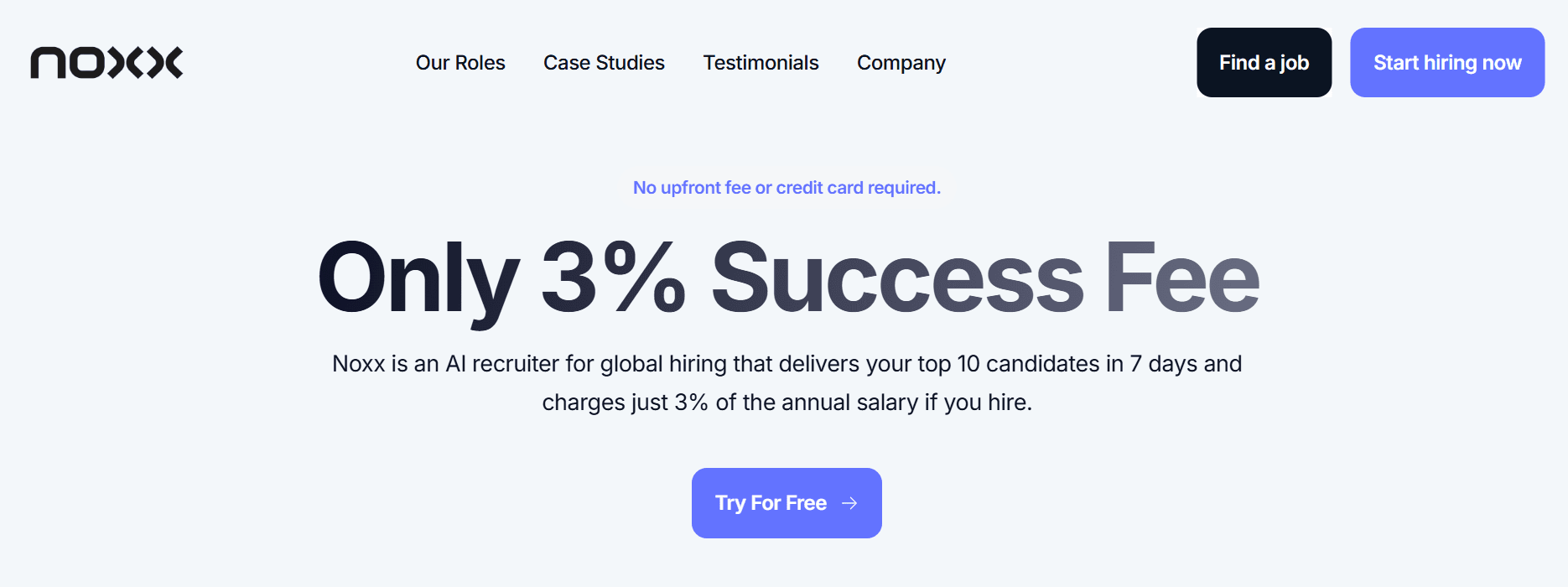
Noxx automates sourcing and screening to deliver the top 10 candidates within seven days by scanning over 1,000 applicants. It targets startups and small teams that need quality engineers, marketers, and salespeople without long timelines or high recruiter fees. Upload a job description, review salary expectations up front, and let the platform surface matched candidates while you focus on selection.
Why I Picked Noxx
I included Noxx because it pairs aggressive automation with a simple pricing model that transfers hiring risk to the provider. The model emphasizes candidate quality and speed, while automated bulk screening reduces wasted time on poor fits. For teams hiring internationally or on tight budgets, the stated cost savings and the pay-on-hire approach are practical differentiators.
Standout Features and Integrations
Automated bulk resume screening across 1,000-plus applicants
Top 10 candidate shortlists delivered in seven days
Salary expectation visibility in candidate profiles
Focused candidate matching for engineers, marketers, and sales
No upfront fees, pay only if you hire
Integrations: Typically supports job description upload and common ATS exporting; confirm API or ATS integrations during onboarding.
Pros:
Very low upfront cost and pay on hire reduces financial risk
Fast turnaround for a shortlist suitable for time-sensitive roles
Clear salary expectations reduce negotiation surprises
Cons:
Limited to the roles and geographies Noxx actively sources for
Less control over sourcing channels compared with running your own talent campaigns
2. Greenhouse

Greenhouse is an applicant tracking and recruiting platform that helps teams build organized talent pipelines and run structured interview programs. It suits small to large teams that want consistent scorecards, candidate nurturing, and data-driven hiring workflows. The platform stores candidate data and supports process measurement through KPIs and reporting.
Why I Picked Greenhouse
I picked Greenhouse for its emphasis on structured interviewing and anonymized evaluation to reduce bias. The product team builds features around hiring best practices and provides a mature set of tools for consistent candidate assessment. Organizations that want to scale fair hiring processes find a valuable platform for standardization and measurement.
Standout Features and Integrations
Anonymized candidate evaluation and structured interview scorecards
Pipeline and talent pool management with candidate nurturing
Diversity hiring tracking and reporting
Automated sourcing and applicant tracking
Integrations include BambooHR, Bob, Calendly, DocuSign, Eightfold, Gem, GoodHire, HackerRank, LinkedIn Recruiter, Namely, and more.
Pros:
Strong support for DEI tracking and bias reduction in evaluation
Onboarding is included and helps teams adopt best recruiting practices
Solid base plan value for many small teams
Cons:
Pricing tiers are not always transparent for buyers
Advanced business intelligence is reserved for higher-tier plans
3. Workable Recruiting
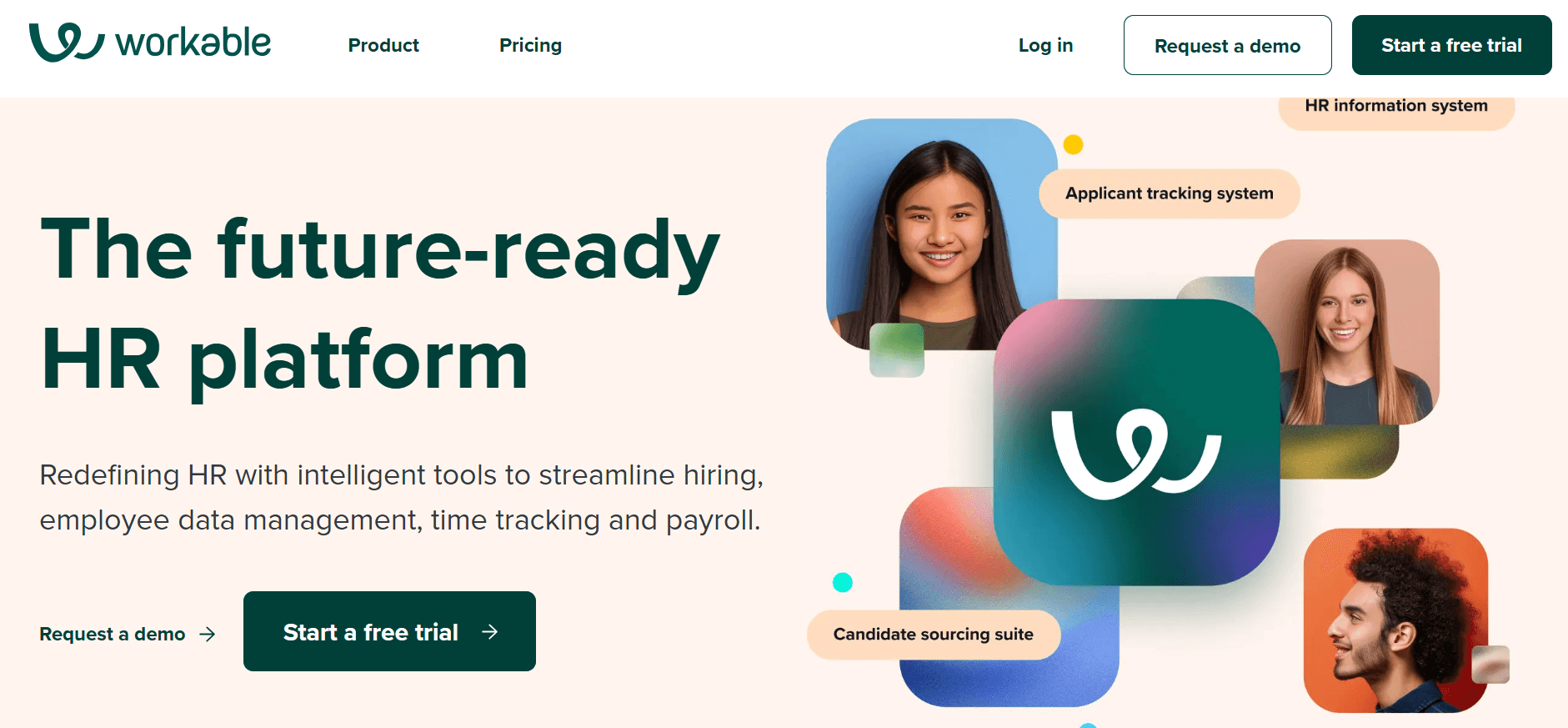
Workable combines applicant tracking with broad sourcing automation so hiring teams get reach and process control from a single product. It is suited to fast-growing companies and recruiting teams that need to post widely, source passive candidates, and manage interviews without fragmentation. The interface focuses on ease of use while supporting complex workflows for technical hiring.
Why I picked Workable
Workable stands out for its automated job posting across many boards and its passive candidate search that compiles public contact details and social links. The ATS automates resume parsing, candidate scoring, and communication templates, which cuts manual workload. Teams that recruit across channels gain time and consistent candidate records.
Standout Features and Integrations
Automated multi-board job posting and social distribution
Passive candidate crawling and profile enrichment
Resume parsing, candidate scoring, and workflow automation
Interview scheduling and automated email templates
Integrations include LinkedIn, Indeed, Google Calendar, Slack, Outlook, Zapier, BambooHR, Greenhouse, Zoom, Asana, Trello, DocuSign, G Suite, Office 365, Monster, Facebook, Twitter, Glassdoor, and more.
Pros:
Comprehensive analytics and tracking for recruitment metrics
Centralized candidate profiles with rich activity history
Intuitive user interface for hiring teams
Cons:
Pricing can be high for tiny teams
Initial setup and data migration may require vendor support
4. GoodTime
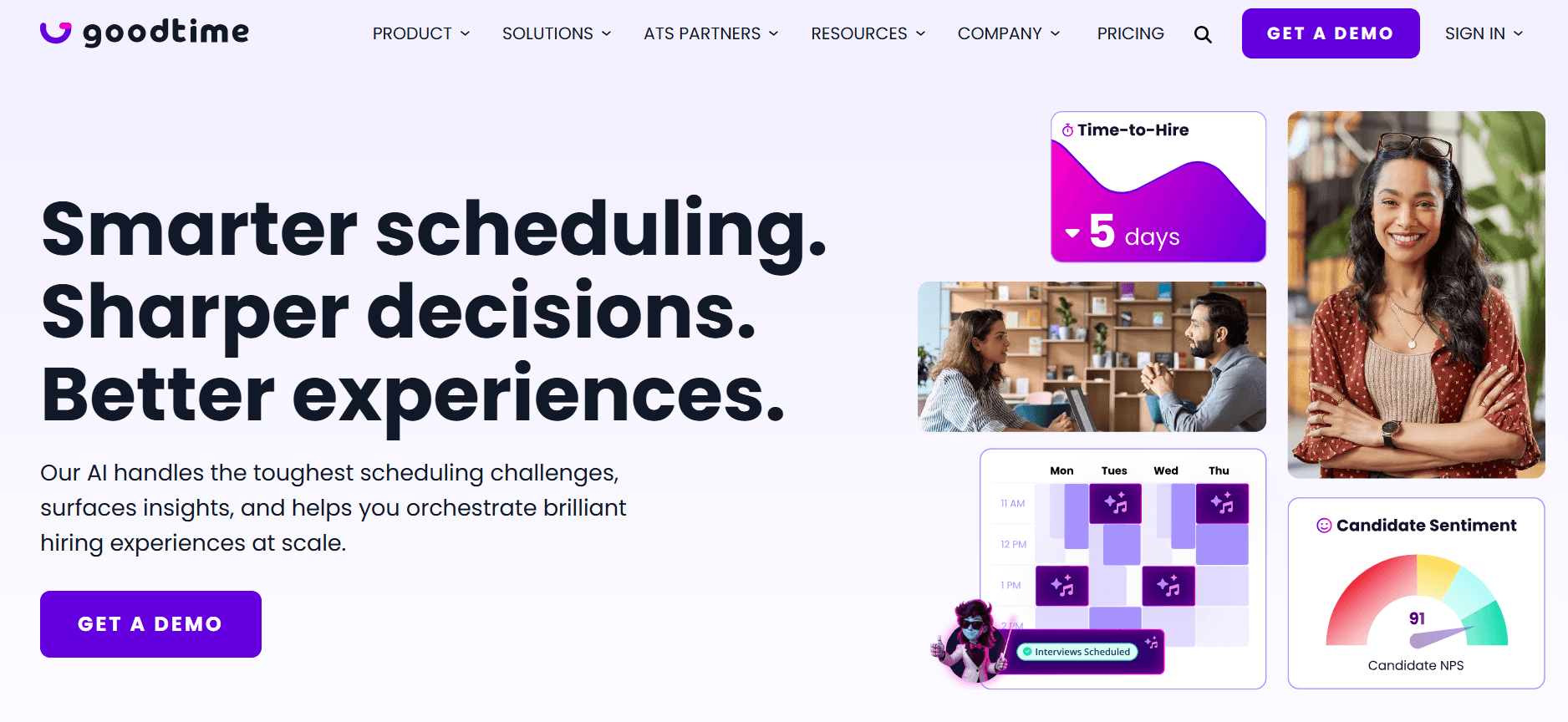
GoodTime is an interview orchestration platform that automates complex scheduling, interviewer selection, and interviewer load balancing. It targets enterprises and high-volume hiring teams that need fast candidate scheduling without manual coordination. The product also supports anonymized candidate handling and training tracking for interviewers.
Why I Picked GoodTime
I chose GoodTime for its AI-driven scheduling engine that considers multiple constraints and replaces interviewers automatically when conflicts arise. The tool reduces scheduling friction for multi-day panel interviews and helps maintain a consistent candidate experience. For organizations that run many concurrent interviews, GoodTime saves recruiter hours and reduces no-shows.
Standout Features and Integrations
AI-driven scheduling and interviewer selection
Auto-replace for declined interviewers and template-based workflows
Interviewer training, tracking, and candidate self-selection for time slots
Integrations include Greenhouse, Lever, Workday, SmartRecruiters, Jobvite, iCIMS, SuccessFactors, Google Calendar, Microsoft Office 365, Outlook Teams, Zoom, Slack, DocuSign, and others.
Pros:
Cuts scheduling time dramatically for complex interview rounds
Strong automation for interviewer selection and backup replacements
Templates and branding keep candidate experience consistent
Cons:
Implementation can require significant configuration effort
Some teams experience a learning curve during rollout
5. Manatal
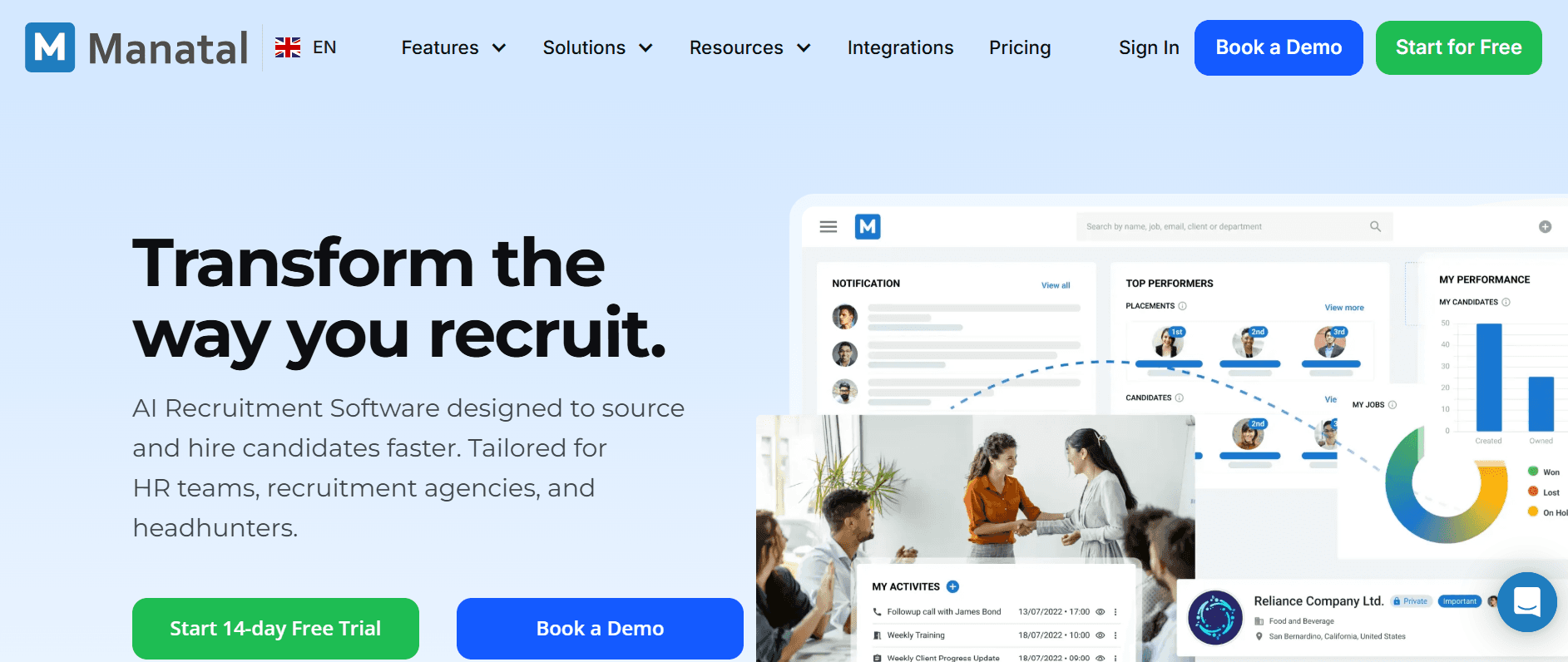
Manatal uses AI to recommend candidates by scanning job descriptions and matching talent pool profiles. It is aimed at HR teams, recruitment agencies, and headhunters who need fast shortlists and social media sourcing tools. The product also includes a Chrome extension for importing LinkedIn profiles and multi-platform job sharing.
Why I picked Manatal
I added Manatal because its candidate matching tool is practical and easy to use, and it integrates well with social sourcing flows. The Chrome extension and multi-channel sharing simplify outreach, while the AI recommendations reduce manual screening time. Small teams and agencies get value from its simplicity and low setup friction.
Standout Features and Integrations
AI candidate matching based on skill extraction from job descriptions
Chrome extension for LinkedIn profile import and social sharing
Kanban pipeline and multi-stage recruitment workflows
Integrations include CareerBuilder, Facebook, Google Calendar, Indeed, LinkedIn, Outlook, Seek, WeChat, WhatsApp, ZipRecruiter, and more.
Pros:
Visual Kanban pipeline speeds review and movement of candidates
Unlimited multi-stage pipelines for diverse hiring processes
Straightforward reporting on hiring activity
Cons:
Career pages lack multilingual support
Archived candidate profiles cannot be unarchived into the same search sequence
6. Boon
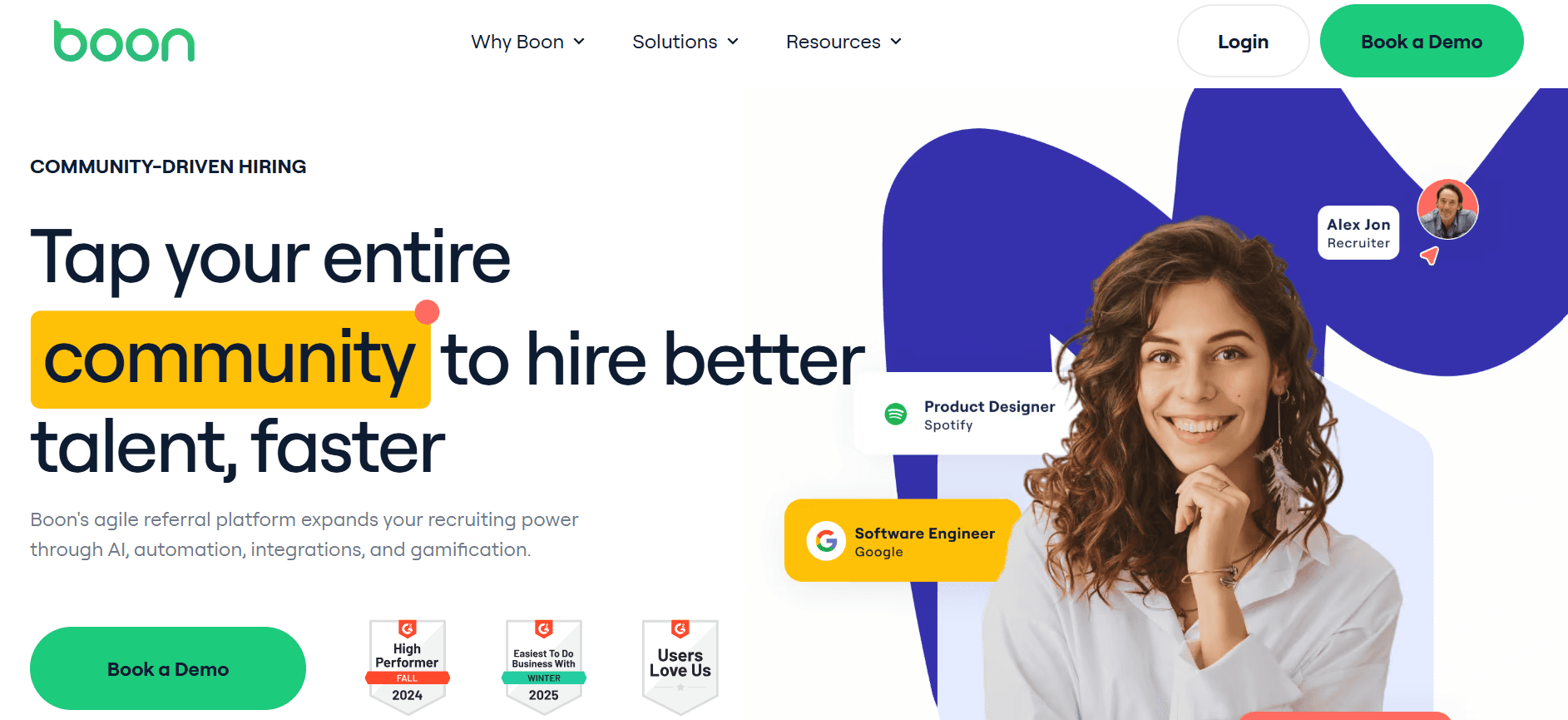
Boon automates referral programs by mobilizing employees, partners, and communities to surface passive talent. It works well for companies that prioritize referrals and diversity while reducing sourcing costs. The platform tracks referrals, automates engagement, and reports on program performance.
Why I picked Boon
I selected Boon for its focus on gamified referrals and multi-brand management, which increases referral participation and helps hiring across divisions. The built-in analytics and automated candidate matching improve referral quality and reporting. For firms that want to scale employee-sourced hiring, Boon reduces admin and increases pipeline diversity.
Standout Features and Integrations
Gamification and customizable referral rewards
AI-powered candidate matching from network connections
Multi-brand management and referral tracking dashboards
Integrations include Greenhouse, Workday, Lever, SmartRecruiters, JazzHR, Workable, BambooHR, Freshteam, Slack, Microsoft Teams, LinkedIn, Google Workspace, Okta, Deel, Gusto, NetSuite, and more.
Pros:
Works even without direct integrations to start referral programs
Gamification increases employee participation in referrals
Good at surfacing passive candidates through networks
Cons:
No free trial in many cases, which slows evaluation
Focus is referral-centric and not a complete ATS replacement
7. Recruit CRM

Recruit CRM merges CRM capabilities with applicant tracking, targeting recruitment agencies and high-volume recruiters. The platform supports rich candidate databases, custom automation recipes, and workflows tailored to sustained sourcing and client management.
Why I Picked Recruit CRM
I included Recruit CRM for its deep customization and automation recipes that let teams build bespoke workflows. The time machine feature, which applies workflows to past records, is unusual and useful for retroactive data hygiene. Agencies benefit from the combined CRM and ATS model to manage candidates and client relationships in one place.
Standout Features and Integrations
Customizable automation recipes and workflow rules
Time machine feature to apply workflows retroactively
Chrome extension for quick data capture from web sources
Integrations via Zapier connect to many HR and productivity tools.
Pros:
Combines CRM and ATS workflows for agencies and high-volume teams
Highly customizable database and automation options
Useful browser extension for sourcing
Cons:
Performance can lag in larger databases
Does not include a native chatbot for candidate engagement
8. myInterview
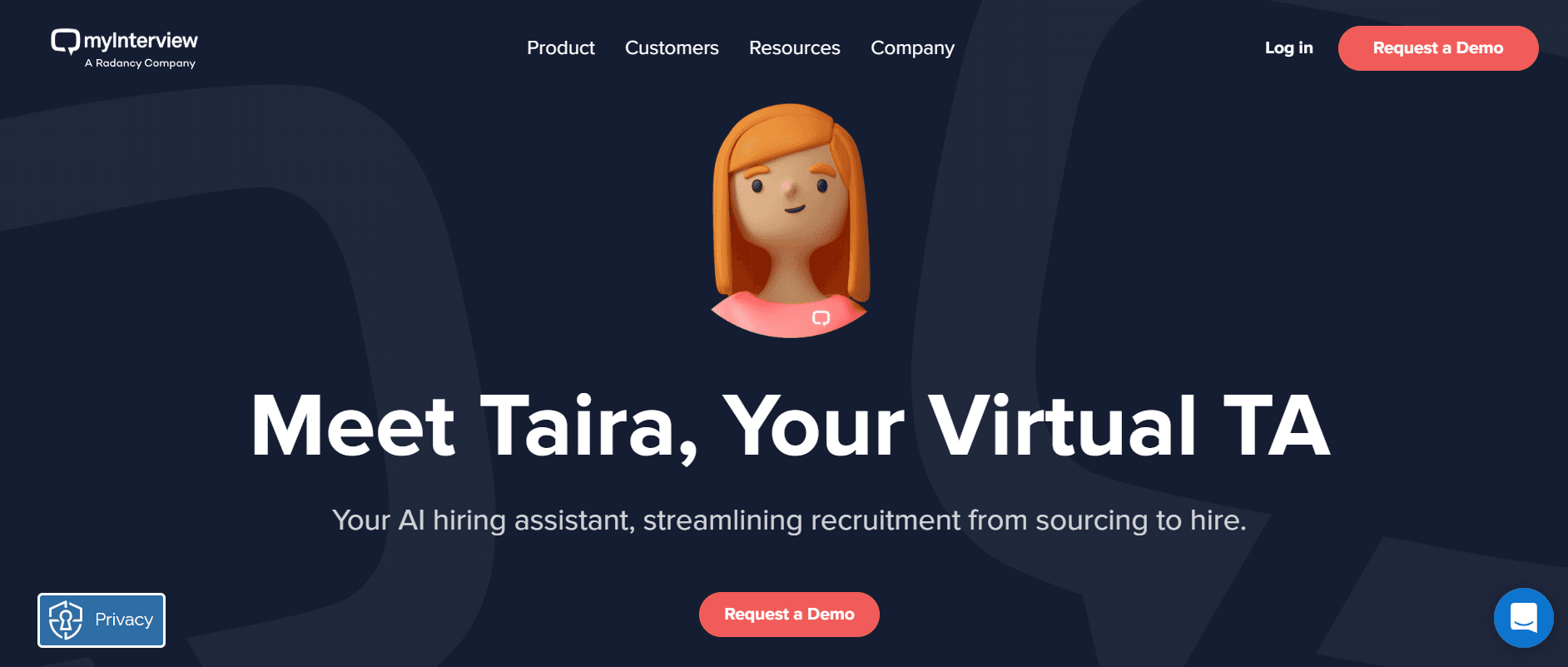
myInterview automates early stage screening with asynchronous video interviews that candidates record on their schedule. Recruiters set custom questions and use AI driven shortlisting to find candidates whose responses align with job criteria. It fits hiring teams that want to reduce phone screens and keep candidate experience personal.
Why I picked myInterview
I picked myInterview because asynchronous video cuts scheduling friction and lets recruiters examine candidate responses at scale. Their machine learning features and searchable response summaries speed shortlisting and make first-stage decisions more straightforward. The GDPR compliance and candidate-friendly interface support global hiring and privacy needs.
Standout Features and Integrations
Pre-recorded candidate interviews and custom question sets
Machine learning driven shortlisting and searchable response highlights
Candidate scoring and analytics to speed early-stage selection
Integrations: API available for custom ATS integrations; standard ATS connectors available on request.
Pros:
Automations compress the first and second stage screening time substantially
GDPR compliant and candidate-centric experience
Personalized video introductions can boost an employer's brand
Cons:
Advanced features are often restricted to top-tier plans
The native integration list could be broader for plug-and-play setups
9. Wizehire
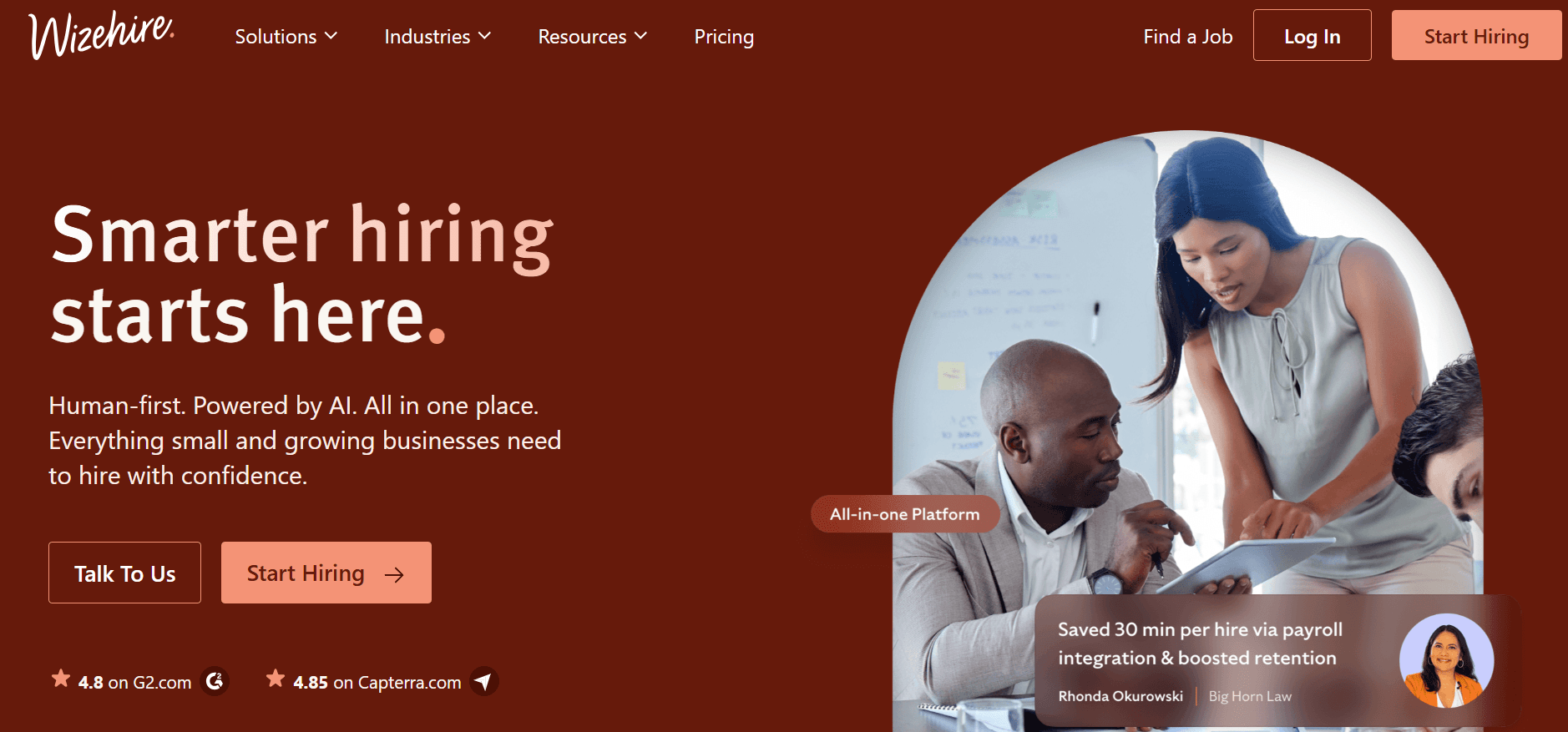
Wizehire combines automated job posting to 100-plus boards with coaching support and assessment tools tailored to small businesses. It streamlines candidate flow and adds human review to help teams refine job ads and make better selection decisions.
Why I picked Wizehire
I chose Wizehire for its mix of automation and human support, which helps small teams that lack recruiting experience. The platform posts broadly, scores candidates, and pairs that automation with coaching to improve selection. For employers seeking direction and distribution, this balance can speed up hiring without compromising quality.
Standout Features and Integrations
One click posting to over 100 job boards
DISC assessments and data-driven recommendation engine
Candidate tracking and evaluation workflows
Integrations include ADP Workforce Now, Checkr, Dropbox Sign, Gusto, Indeed, LinkedIn, QuickBooks, RUN by ADP, Zapier, Salesforce, and HubSpot.
Pros:
Wide job board coverage with simple posting workflow
Assessment tools and coaching help with candidate fit
Good for teams that need expert guidance
Cons:
Some integrations are limited to higher-tier plans
Assessment customization options are modest
10. JazzHR
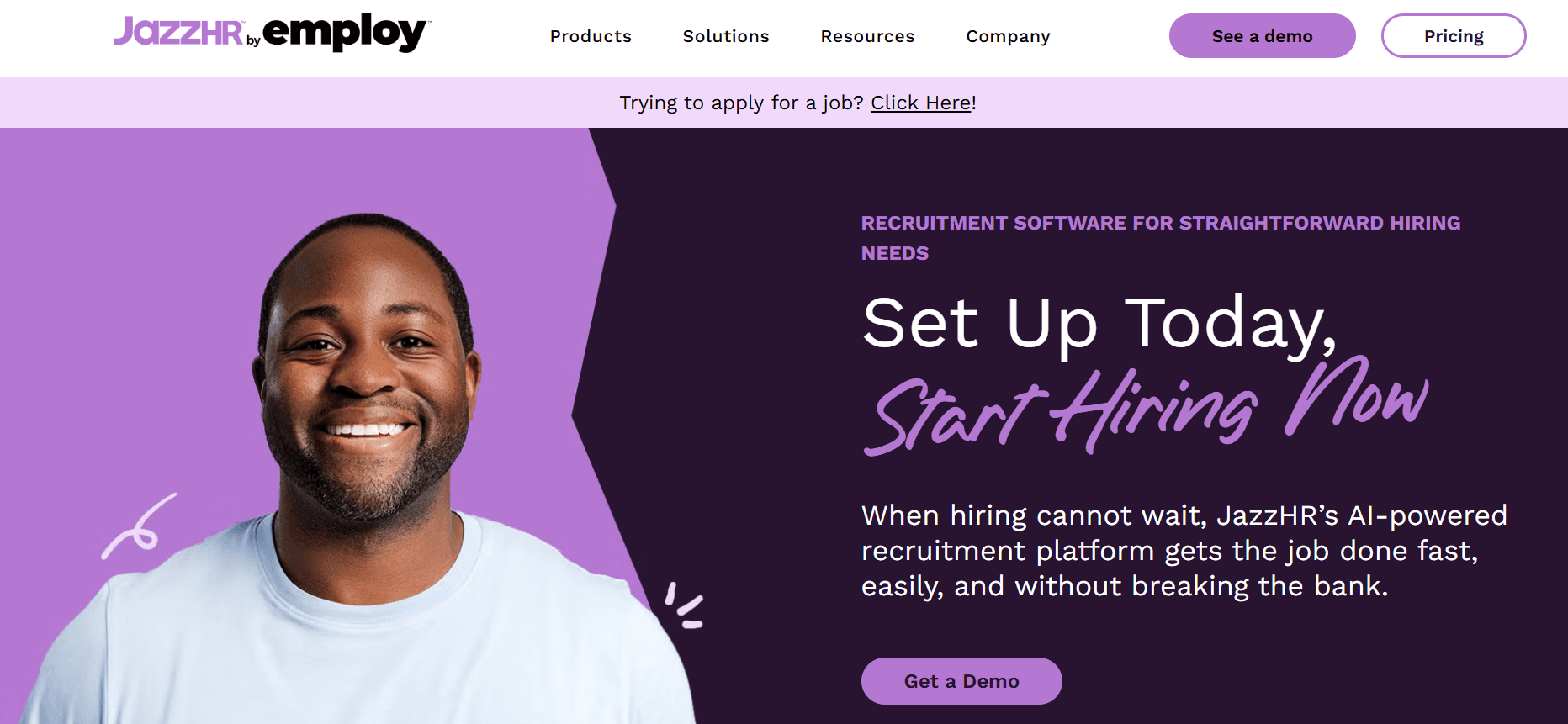
JazzHR is an ATS built for small and medium businesses that want quick deployment and customizable workflows. It provides prebuilt templates, knockout questions, and bulk actions to automate candidate filtering and pipeline management. The focus is on speed to value and simple recruiter workflows.
Why I picked JazzHR
I picked JazzHR for its easy out-of-the-box usability and the ability to customize workflows as needs evolve. The knockout question feature automates initial filtering, and bulk actions speed candidate management for busy hiring teams. For organizations that want a practical ATS without heavy configuration, JazzHR delivers.
Standout Features and Integrations
Knockout screening questions and bulk candidate actions
Custom automated pipelines and activity streams for team collaboration
Pre-developed interviewer question libraries
Integrations include ADP, BambooHR, Gusto, Verified First, and Checkr.
Pros:
Simple initial screening and fast access to candidate details
Prebuilt templates accelerate recruiter adoption
Bulk actions reduce repetitive tasks
Cons:
No task creation for team members in some plans
Reporting features are basic compared with larger platforms
11. SeekOut

SeekOut is a talent discovery platform that searches hundreds of millions of profiles to find passive and niche candidates. It is aimed at technical recruiting, diversity hiring, and employers who need to build complex pipelines. The product enriches candidate data and offers AI-assisted outreach templates.
Why I picked SeekOut
I included SeekOut because it excels at finding hidden candidates and building targeted, diverse pipelines. The ability to save search strings and use power filters helps sourcers work faster and more precisely. Talent teams that need to fill specialized roles will find the depth of data valuable.
Standout Features and Integrations
AI-assisted candidate sourcing and enrichment
Saved searches, custom filters, and targeted outreach generation
Candidate data refresh and internal talent mapping tools
Integrations include Ascendify, Ashby, Crelate, Gem, Greenhouse, iCIMS, IQTalent, JobDiva, Lever, SAP SuccessFactors, and more.
Pros:
Powerful filters and saved search capabilities speed discovery
Proactive support that helps teams get value quickly
Strong for diversity and technical searches
Cons:
The interface can feel clunky for detailed searches
There is a learning curve for maximum effectiveness
12. Empower by Ringover
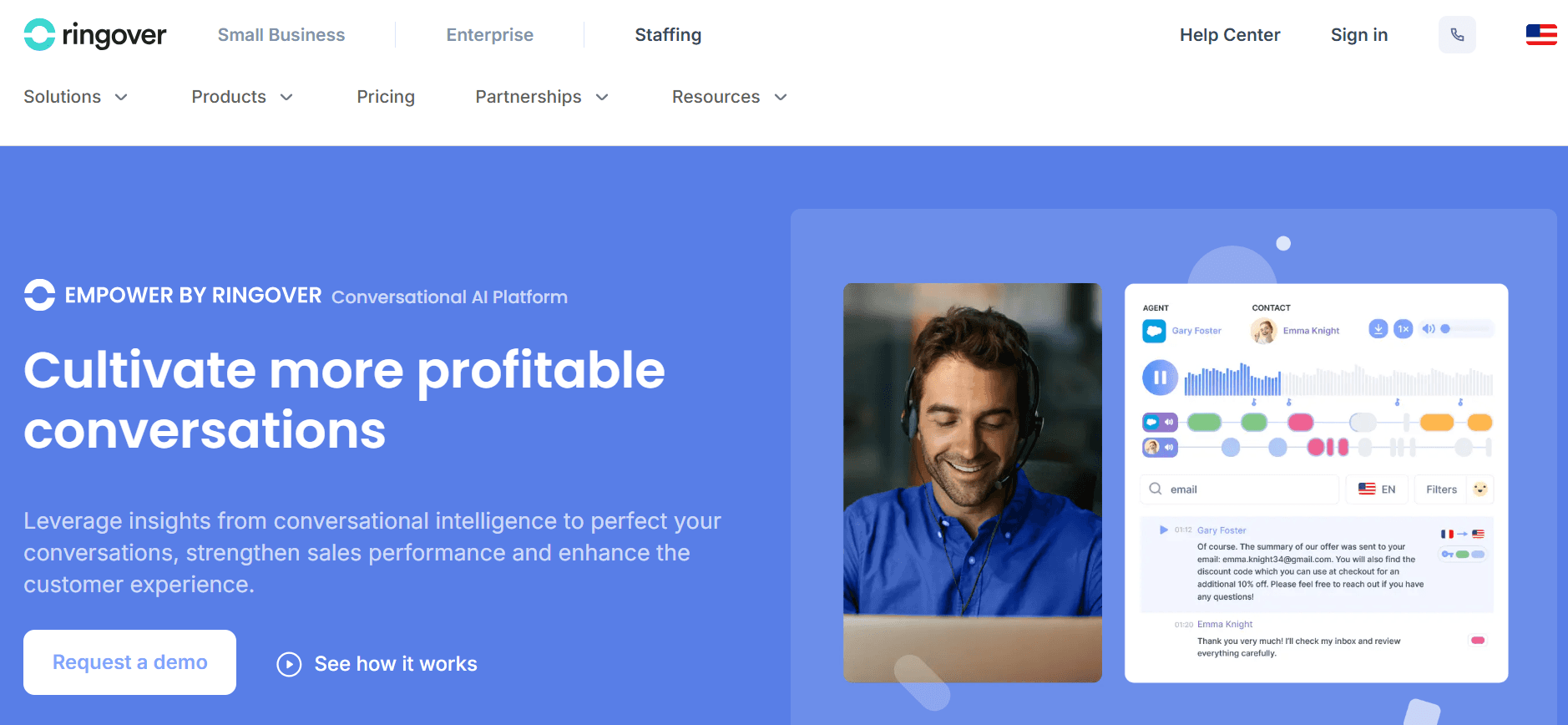
Empower by Ringover analyzes recruiter candidate calls with AI to produce transcripts, call summaries, and coaching insights. It helps hiring teams improve outreach effectiveness, identify best practices, and reduce the time spent reviewing conversations manually. Managers get analytics and a searchable call library for training.
Why I Picked Empower by Ringover
I picked Empower because conversation intelligence addresses a blind spot in many recruiting workflows. The product highlights effective practices in candidate calls, automates feedback, and provides on-demand examples that teams can use to train recruiters. For organizations that rely heavily on phone outreach, the ROI on call efficiency can be tangible.
Standout Features and Integrations
AI call analysis, automated transcripts, and summary highlights
Ask Empower for on-demand call insights and curated call examples
Call library for coaching and calibration
Integrations typically include major ATS and CRM systems; confirm specifics during procurement.
Pros:
Reduces manual review time and accelerates recruiter coaching
Actionable analytics tied to call performance
Cons:
Full value depends on consistent call volume and disciplined use
Integration details vary and may require setup work
13. LinkedIn Recruiter
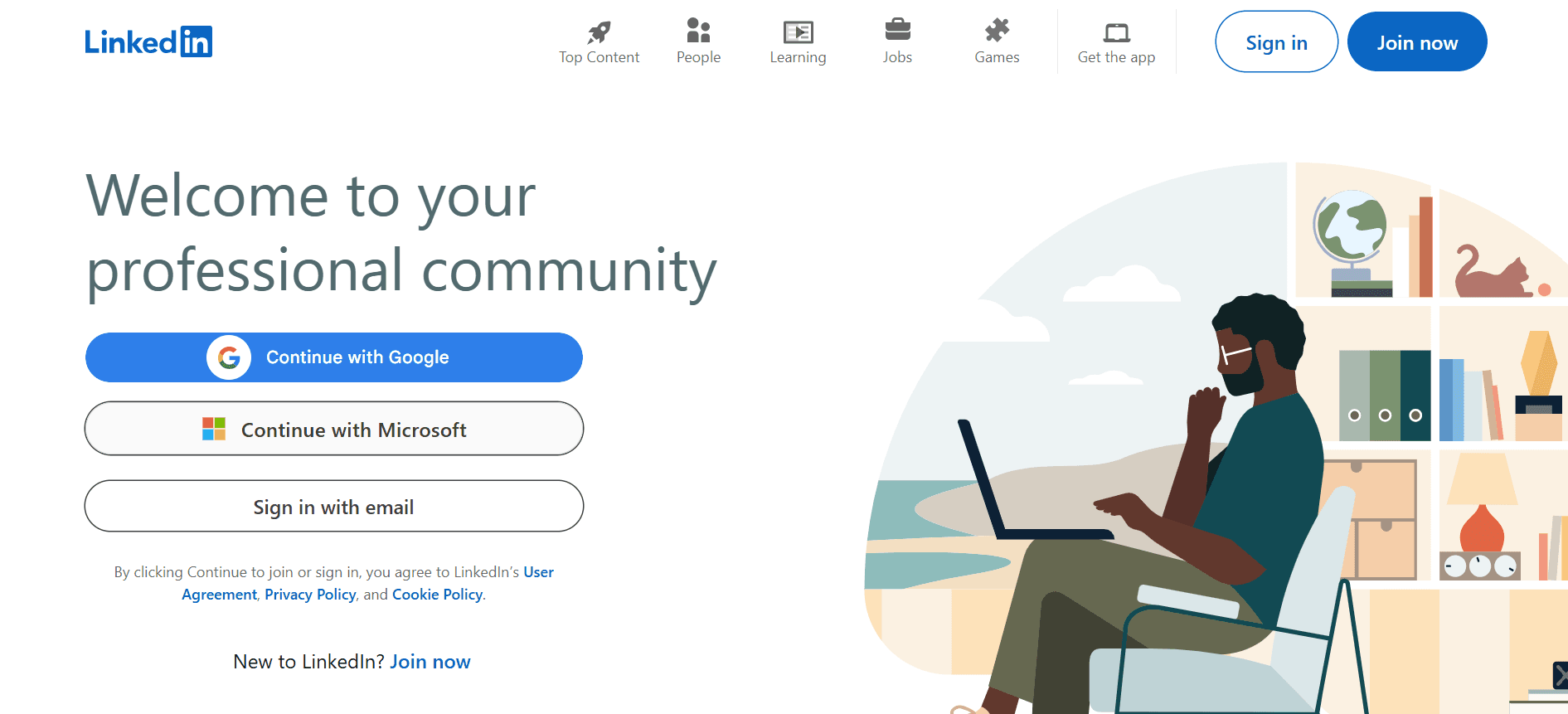
LinkedIn Recruiter taps LinkedIn profile data for sourcing, pipeline building, and candidate outreach. It automates candidate searches, organizes projects, and tracks engagement, allowing recruiters to manage direct outreach and inbound responses efficiently.
14. Indeed Hiring Platform
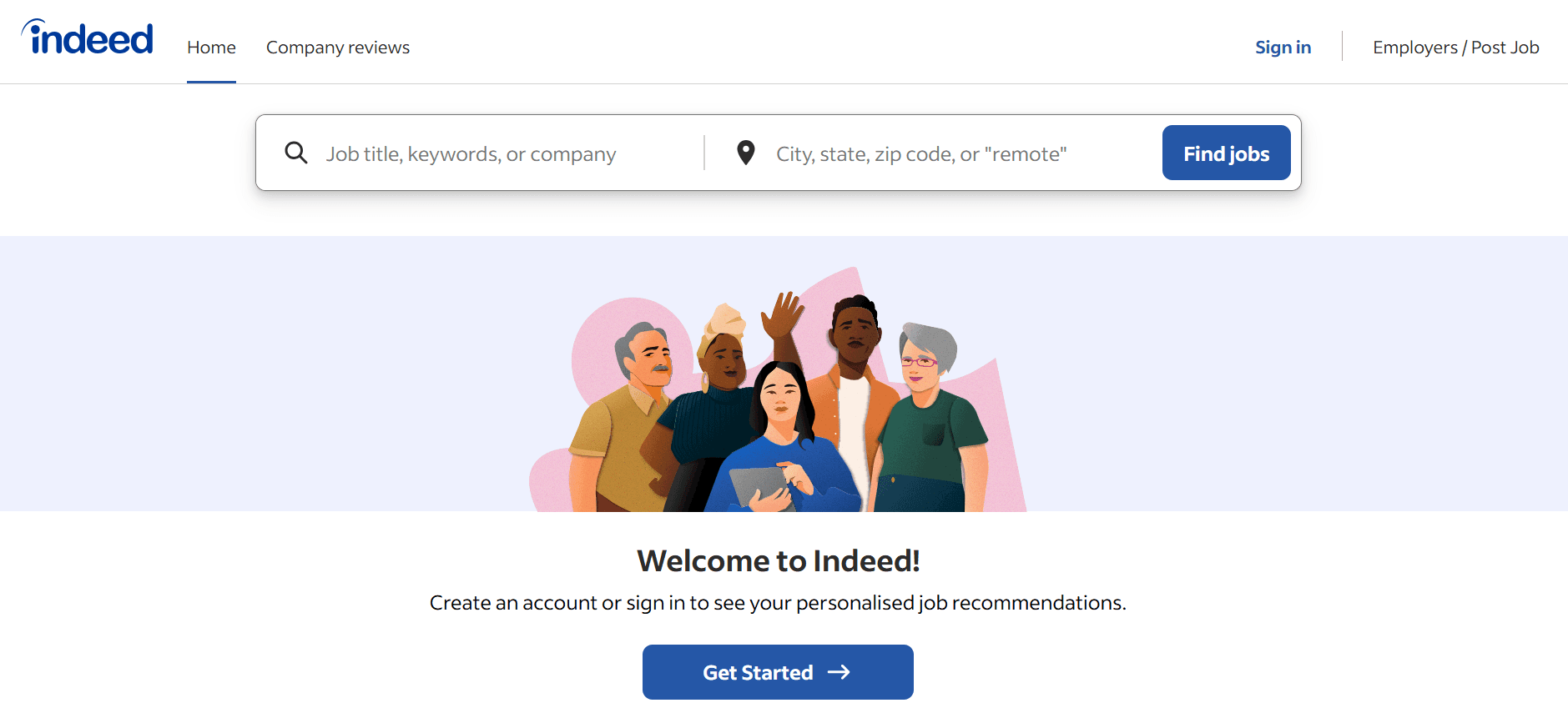
Indeed provides job promotion, candidate parsing, and employer review management across Indeed and Glassdoor. Automation focuses on candidate discovery, sponsored job distribution, and applicant tracking features for volume hiring.
15. Elevatus
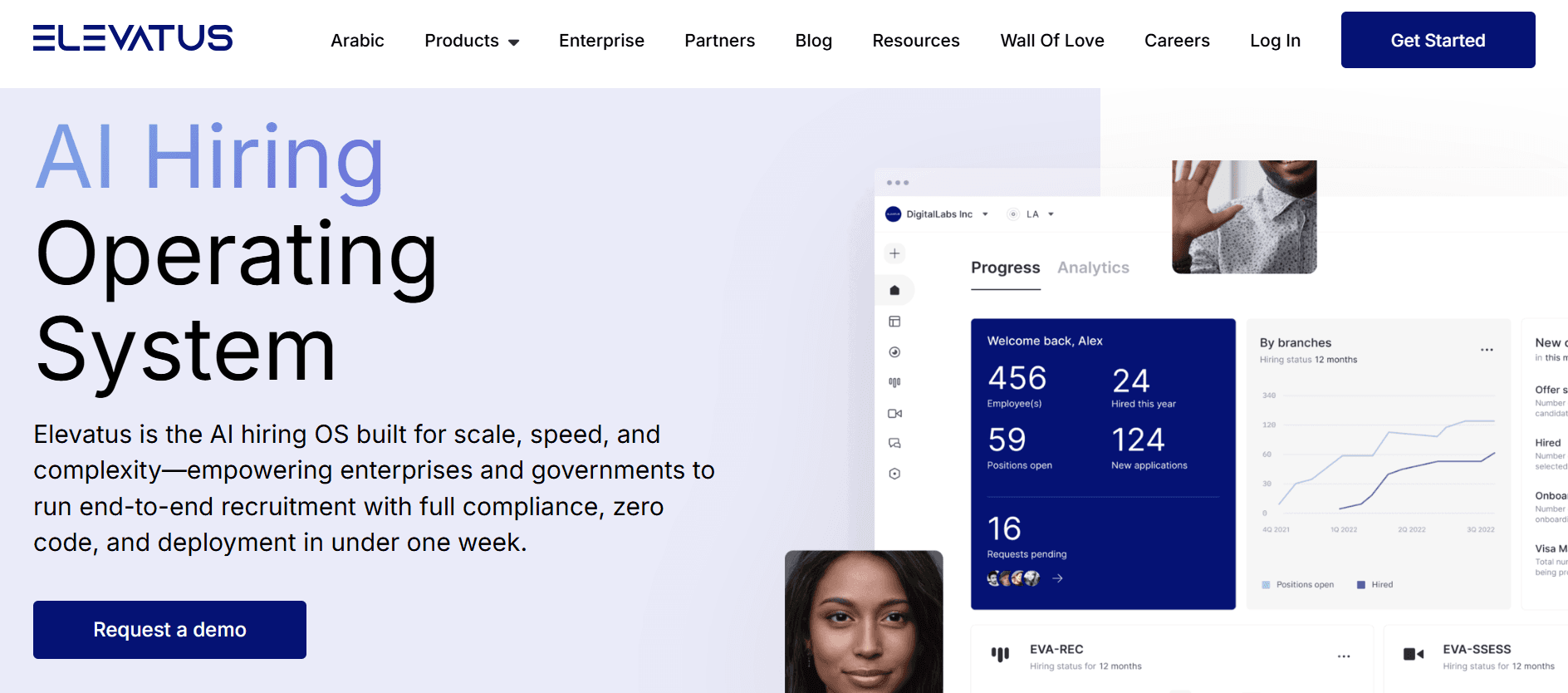
Elevatus automates requisitions, candidate screening, assessments, and onboarding with AI-driven workflows. The platform aims to unify recruiting technology for a paperless process and has global implementations across many industries.
16. SmartRecruiters
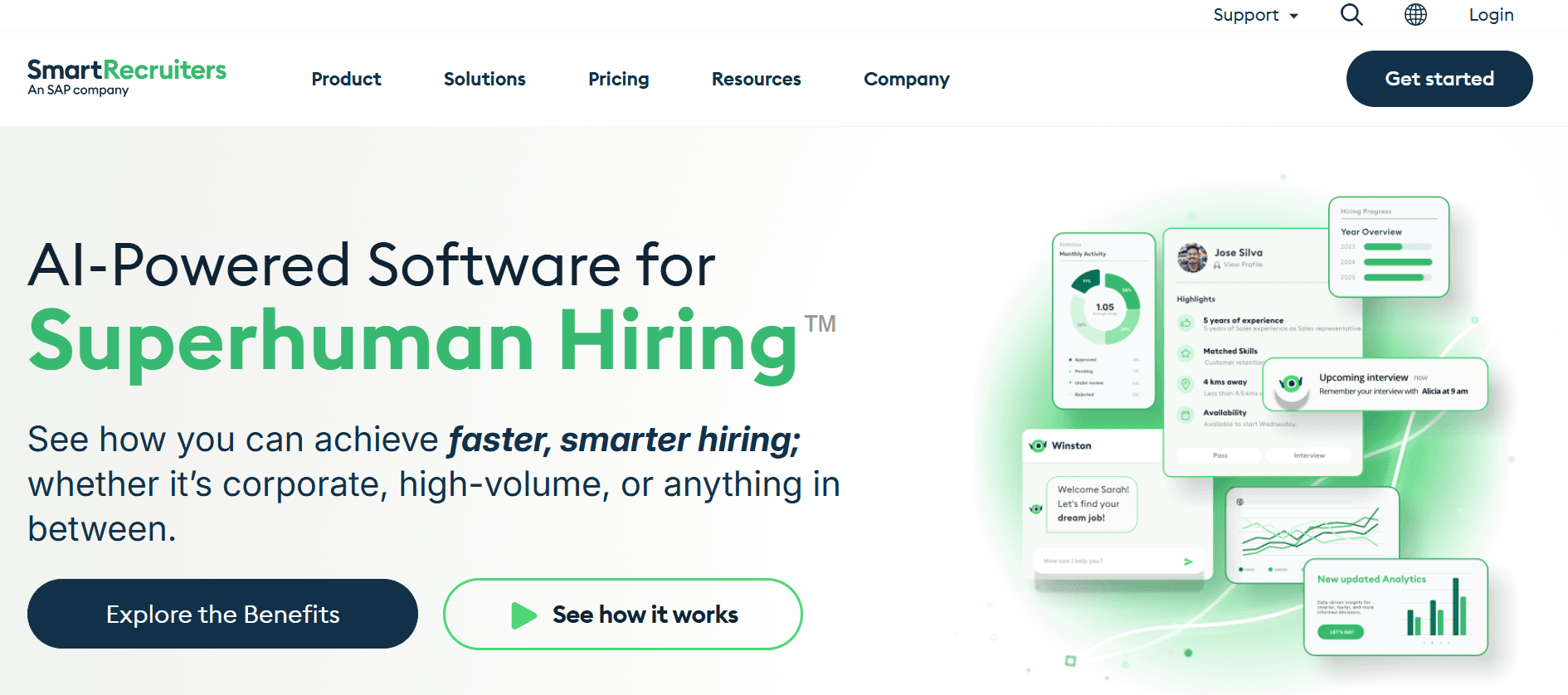
SmartRecruiters covers job posting, career site creation, and multi-channel communication, including chatbots and SMS. It is designed for enterprise-scale hiring with an emphasis on candidate experience and collaborative hiring.
17. Zoho Recruit
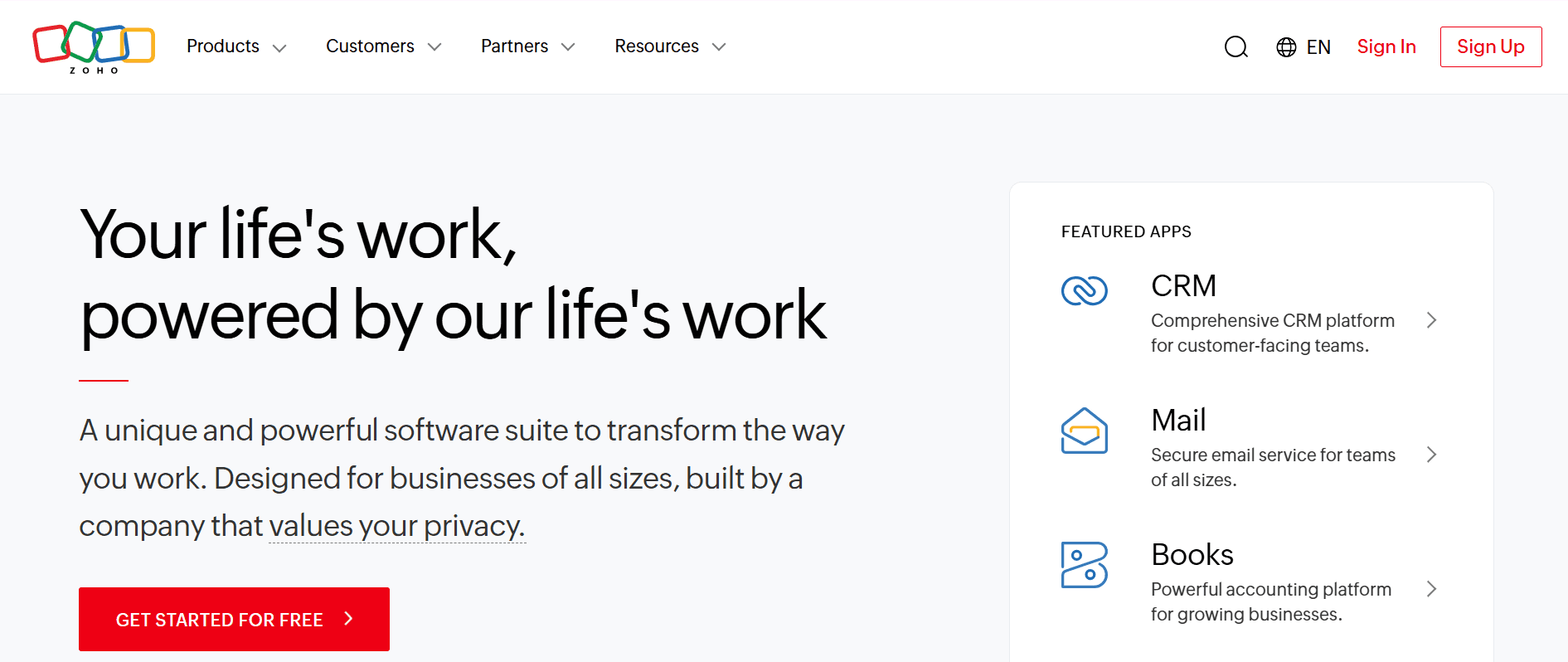
Zoho Recruit focuses on candidate experience while fitting into the Zoho suite for CRM integrations. It provides ATS workflows, branded career pages, and smooth handoff from candidate to employee records.
18. Vincere
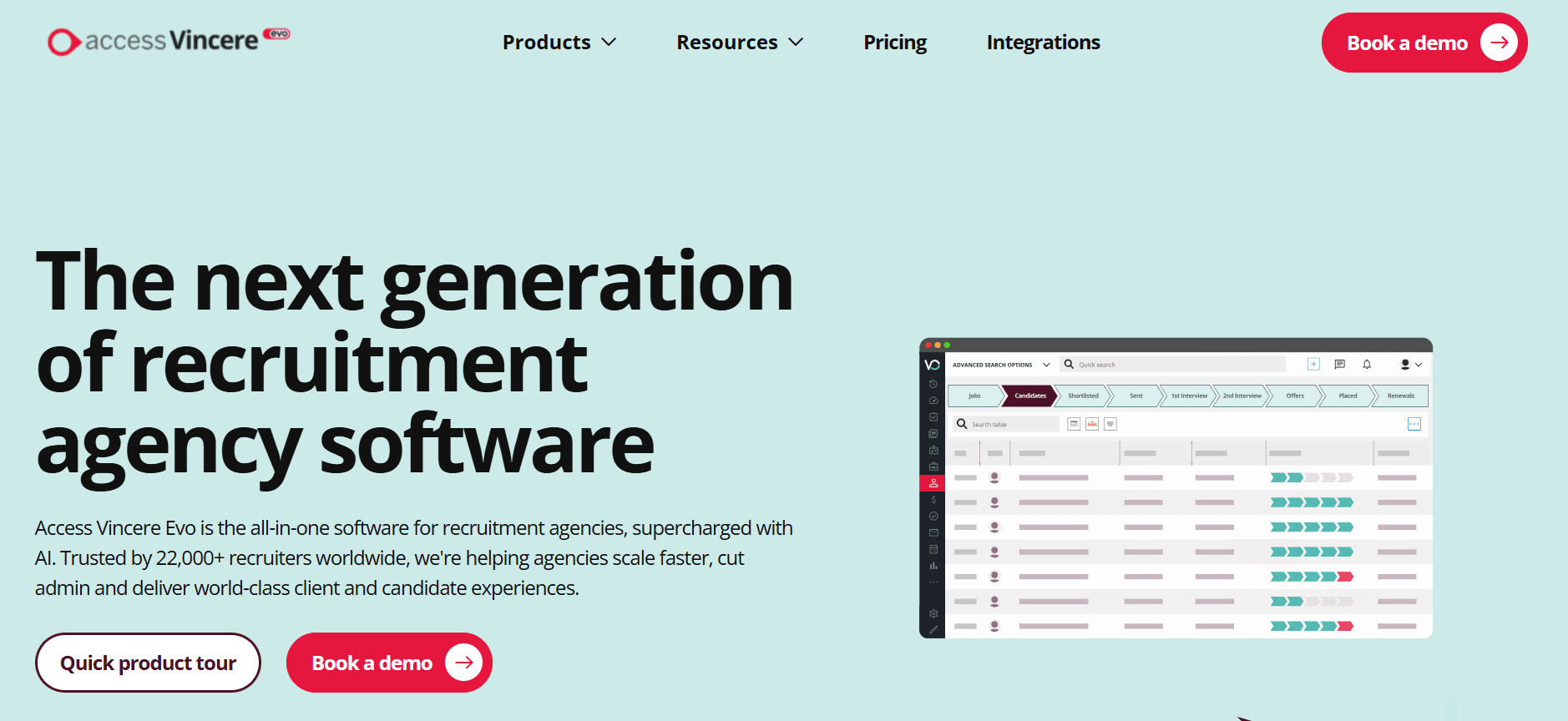
Vincere offers applicant tracking, candidate relationship management, and reporting dashboards built for recruitment agencies. The analytics help teams measure placements and refine sourcing.
19. Paradox
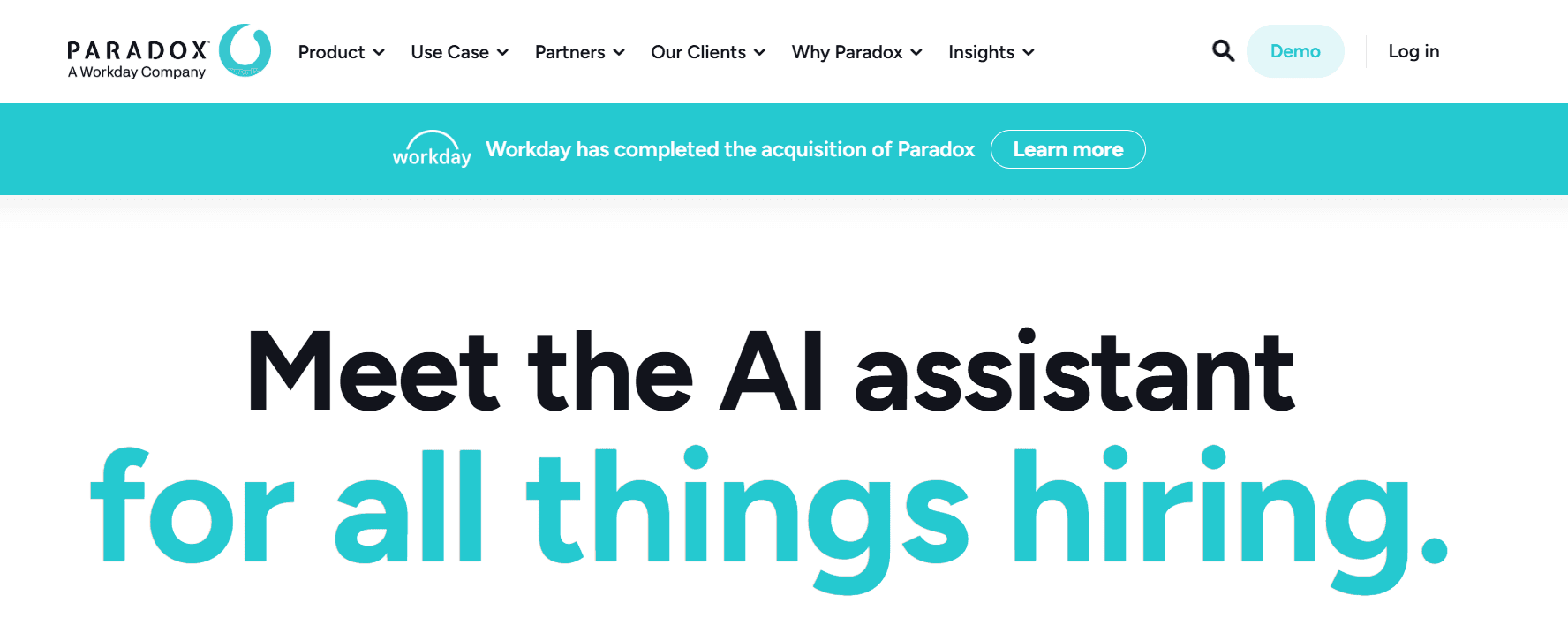
Paradox uses chatbots and automation for scheduling, screening, and candidate engagement. The platform personalizes candidate interactions and reduces administrative back and forth.
20. hireEZ
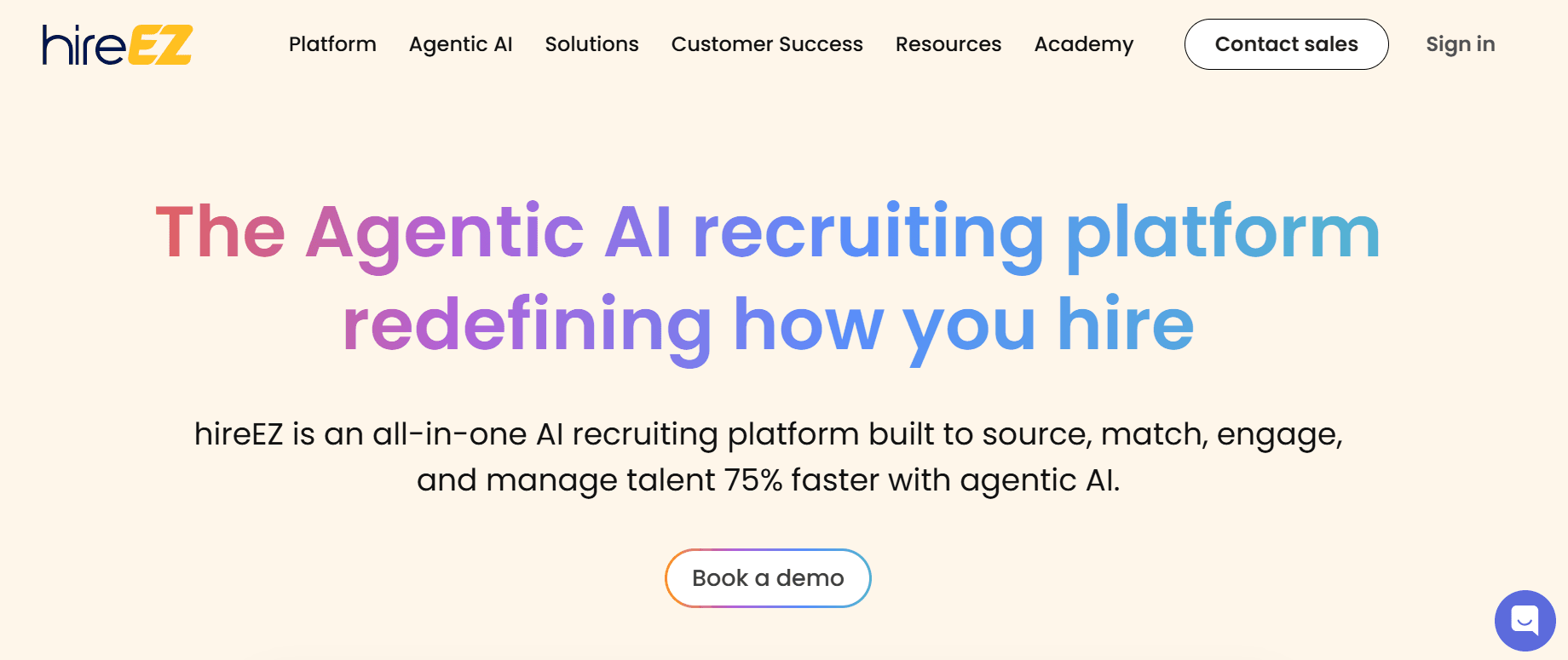
hireEZ provides resume analysis, candidate sourcing, and engagement tools for passive outreach. The tool simplifies complex sourcing tasks and helps recruiters maintain outreach sequences at scale.
21. SourceWhale
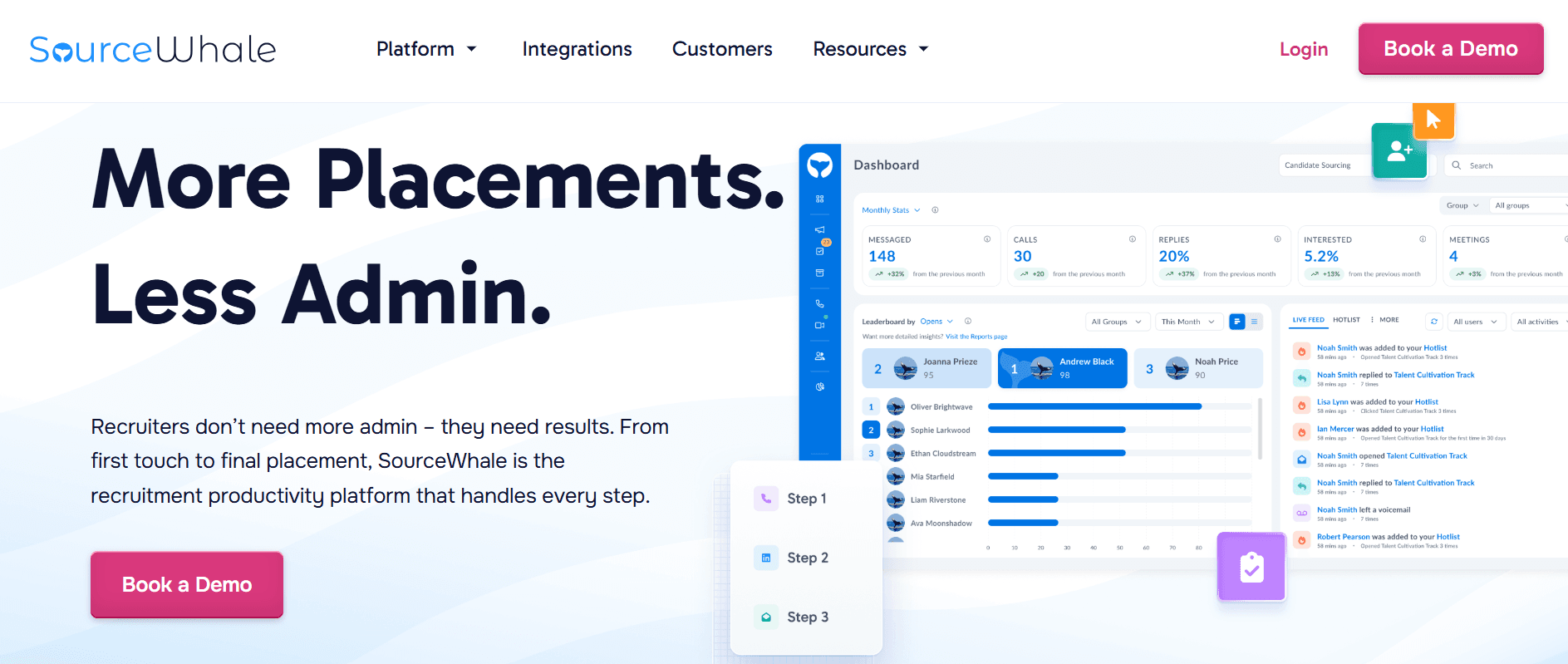
SourceWhale specializes in outbound candidate outreach with search, personalized messaging, and campaign analytics. It helps teams measure response rates and optimize sequences for passive recruitment.
22. Emi
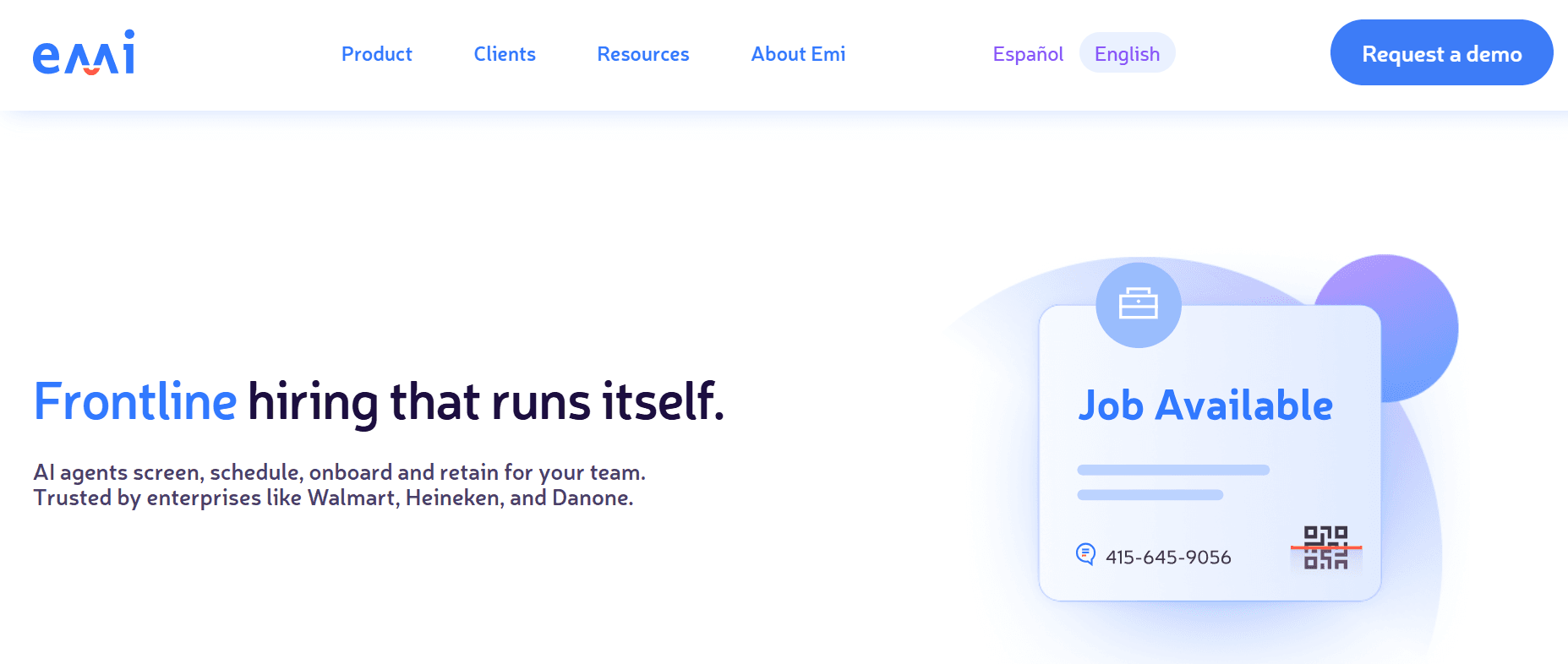
Emi focuses on high-volume hiring workflows with job posting, automated screening, and bulk communications. It is designed to reduce time per hire when filling many roles concurrently.
23. Jobylon
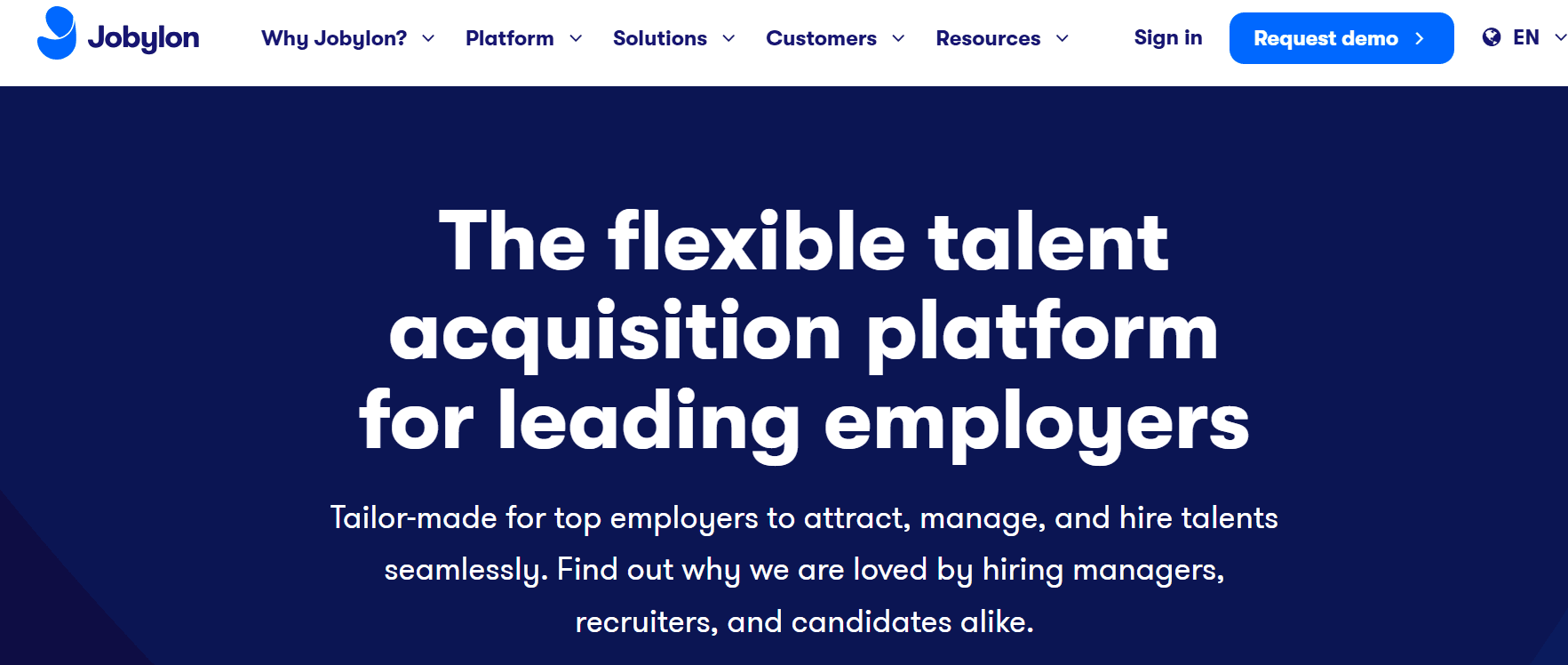
Jobylon covers job posting, pipeline management, and employer branding with an emphasis on user experience. The product aims to keep hiring fast and straightforward for SMBs.
24. HireVue

HireVue delivers live and recorded video interviews with AI-supported assessments and interview scoring. The platform adds analytics to help standardize evaluation and speed decision-making.
25. SeekOut (duplicate entry)

This listing repeats SeekOut, which finds hidden and diverse talent through extensive profile indexing and AI search. It also helps companies surface internal candidates and map skills across existing employees.
26. TurboHire
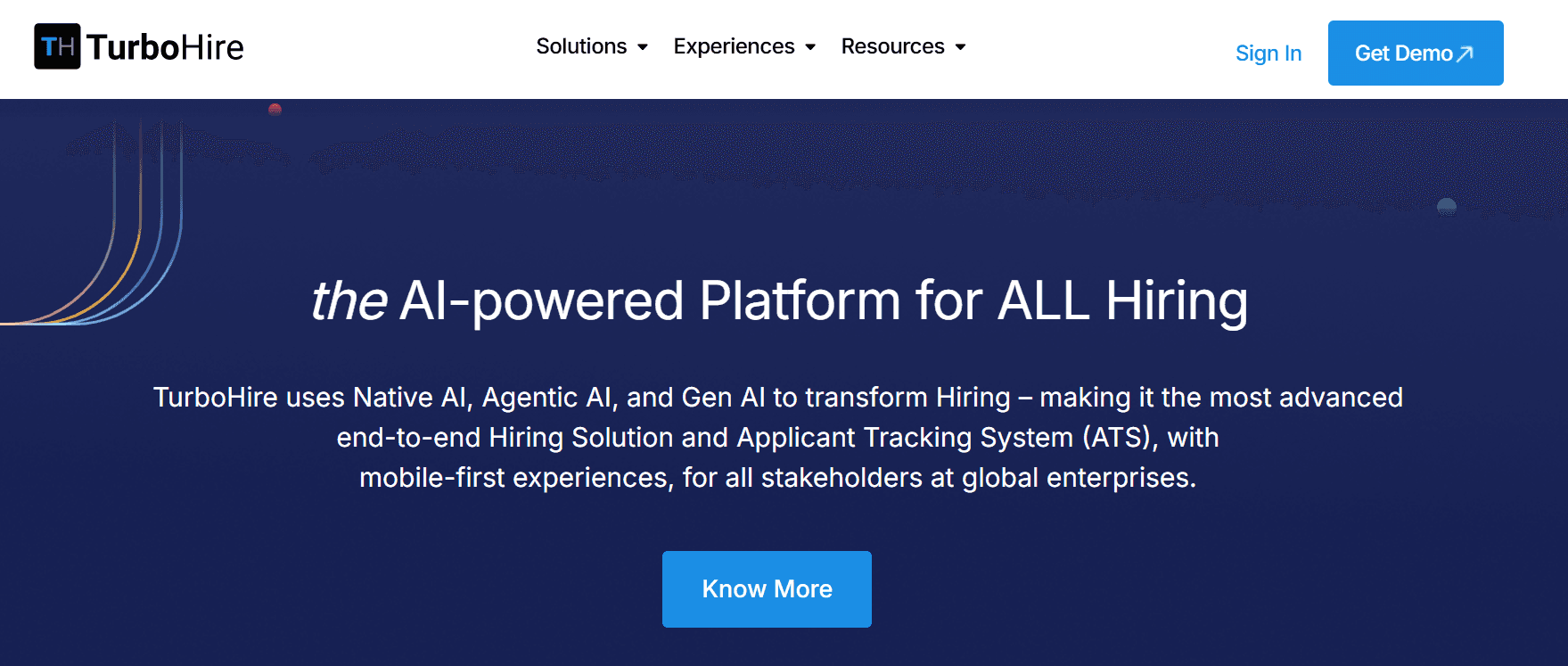
TurboHire offers tools for passive candidate outreach, chatbot-driven engagement, and one-way interviews. It automates candidate scoring and scheduling to speed recruiter workflows.
27. Fetcher
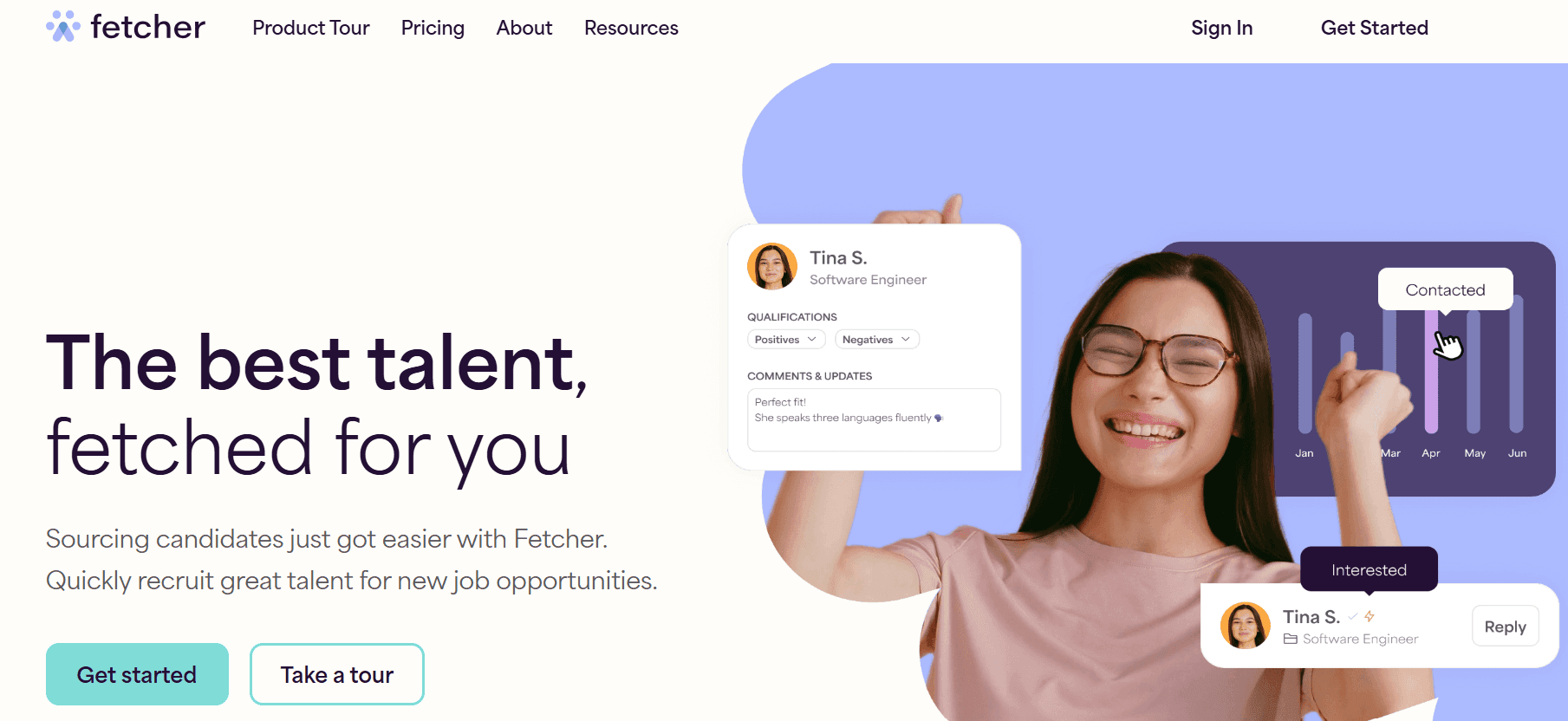
Fetcher automates candidate sourcing and outreach by combining curated sourcing with scheduled email campaigns and analytics. The platform hands off qualified leads to recruiters and monitors campaign performance.
Related Reading
• AI and Recruiting
• Remote Hiring Tools
• AI Recruiting Startups
• AI Recruiters
• Remote Developers Eastern Europe
• Automated Candidate Screening
Upload a Job and Get 10 Candidates within 7 Days with Noxx (No Risk, No Upfront Fees)
Noxx runs your hiring funnel end to end so you do less busy work and more hiring. Upload a job description and the AI recruiter posts the role across job boards, handles applicant tracking, and parses resumes at scale.
It screens over 1,000 applicants automatically, ranks the best fits, and delivers the top 10 candidates in seven days. You pay only $300 when you actually hire someone, with no up front fees or recruiter commissions.
How Noxx Keeps Quality High While Moving Fast
Noxx combines structured skills assessment with behavioral screening to filter noise from signal. Technical tests for engineers, portfolio checks for marketers, and role plays for sales let the AI score candidates objectively before a recruiter or hiring manager reviews them.
Automated reference checks and verification steps cut turnaround time. Continuous candidate engagement through email and SMS maintains response rates and helps capture passive candidates.
Integrations Compliance and Employer Experience
Noxx plugs into your existing ATS calendar and HRIS so data flows without manual exports. Reports cover source attribution diversity hiring metrics and onboarding handoffs. The platform supports privacy and data protection standards required in multiple jurisdictions and lets you customize employer branding throughout the candidate journey.
Related Reading
• Toptal Alternatives
• Companies using AI for Recruitment
• AI Screening
• Toptal vs Gigster
• Andela Competitors
• Turing Alternatives

